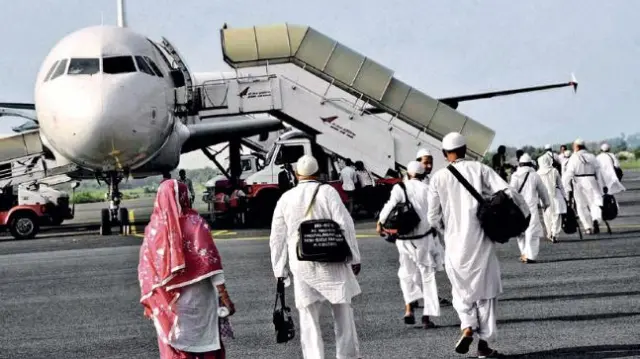Each year, millions of Muslims from across the world travel to Saudi Arabia to perform Hajj — one of the five pillars of Islam. This year, the Kingdom has pulled off another incredible logistical success: 3,314 Hajj flights were operated from 238 cities across the globe, welcoming pilgrims with care, coordination, and high-quality services.
This large-scale effort shows how committed Saudi Arabia is to serving pilgrims and ensuring their sacred journey is as smooth as possible.
A Coordinated Global Operation
Organizing Hajj is no small task. Pilgrims come from nearly every continent, from major capitals to remote towns. To meet the demand and manage the flow of pilgrims efficiently, the Saudi General Authority of Civil Aviation (GACA) worked closely with local airlines, international partners, airport authorities, and government agencies.
These 3,314 flights came from cities big and small — including places in Asia, Africa, Europe, and the Americas — and landed safely in Saudi Arabia’s key entry airports, such as Jeddah, Madinah, Riyadh, and Dammam.
According to officials, this year’s efforts have focused more than ever on efficiency, safety, and passenger experience.
Making Travel Easier for Pilgrims

Preparing for Hajj starts long before the pilgrim boards a plane. From visa approvals to health checks, baggage handling to flight arrangements, the process can be overwhelming. That’s why GACA, in collaboration with the Ministry of Hajj and Umrah, introduced a number of services and systems this year to make the process easier.
These included:
- Pre-check-in processes to reduce airport wait times
- Special assistance for elderly and disabled pilgrims
- Multi-language support at airports
- Fast-tracked immigration services at key locations
Thanks to these systems, passengers reported shorter queues, better organization, and smoother experiences.
“We want every pilgrim to feel welcomed, respected, and taken care of from the moment they start their journey,” said one GACA official.
The Largest Hajj Travel Network in History?
While final figures are still being compiled, many believe this year’s Hajj operation might be the largest and most diverse in recent history in terms of travel logistics. With 238 cities sending pilgrims, the scale of coordination has impressed many in the global travel and aviation sectors.
Some of the busiest departure cities included:
- Jakarta, Indonesia
- Cairo, Egypt
- Karachi, Pakistan
- Lagos, Nigeria
- Istanbul, Turkey
- Dhaka, Bangladesh
- Kuala Lumpur, Malaysia
- London, UK
Many smaller cities also saw their first-ever direct Hajj flights, thanks to improved agreements between countries and Saudi aviation authorities.
A Focus on Safety and Comfort
With thousands of flights coming into the Kingdom, aviation safety remained the top priority. GACA ensured that every aircraft met strict international standards. Airport staff received special training to handle large crowds and assist elderly pilgrims. Baggage handling, ground transportation, and even food services were improved to meet the needs of pilgrims arriving from different cultures and backgrounds.
Hajj is a physically and spiritually demanding journey, and the Kingdom made sure that air travel did not add stress to the pilgrims’ experience.
“We were tired from the journey, but as soon as we landed, everything was easy. The process was quick, and volunteers helped us right away,” said Fatima, a pilgrim from Morocco who flew in with her elderly parents.

A Model for Future Pilgrimage Operations
The success of this year’s air travel for Hajj is being seen as a model for the future. Saudi Arabia has committed to increasing its capacity for pilgrims in the coming years, with goals to host over 30 million pilgrims annually by 2030 under the Vision 2030 plan.
This means more flights, more facilities, and even smarter systems to help pilgrims enjoy a smoother, more meaningful experience.
As part of this vision, the Kingdom is also investing in:
- Airport expansions, especially in Jeddah and Madinah
- Digital tracking systems for pilgrim services
- More international partnerships for direct Hajj routes
- Green aviation policies to make Hajj more eco-friendly
Why the Numbers Matter
The 3,314 flights are not just about transportation. These numbers show the global connection of the Muslim community. People from different languages, cultures, and countries are united by faith, traveling with the same intention: to perform one of the most important rituals in Islam.
From the crowded airport halls in Jakarta to the prayer-filled flights from Casablanca, every journey told a story of devotion and hope.
“This is more than a flight; it is the beginning of a spiritual transformation,” said one airport worker in Jeddah, who greeted thousands of pilgrims with a smile and a prayer.
Human Stories Behind the Flights
Behind each number is a face, a family, a dream. Among the passengers were:
- A group of young pilgrims from Bosnia, traveling for their first Hajj with an elderly imam guiding them
- A woman in her 80s from India, who saved money for 20 years to afford the journey
- A group of orphans from Senegal, whose travel was funded by a charitable organization
- Newlyweds from Canada, starting their married life with a spiritual trip to Makkah
These stories highlight how deeply important Hajj is to people worldwide — and how the Kingdom’s efforts make it possible for people of all walks of life to fulfill this dream.
Looking Ahead
While the arrival phase has been a success, the focus will now shift to return flights once pilgrims complete their Hajj rituals. GACA and its partners have already activated plans to ensure that departures will be just as smooth and respectful as arrivals.
Also read: Saudi Arabia Gears Up for Hajj 2025 With Smart Digital Upgrades


